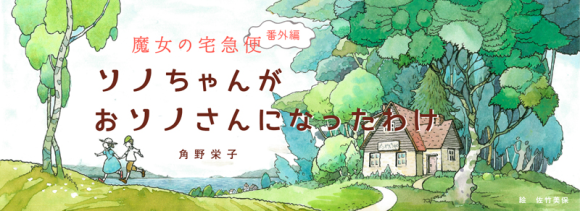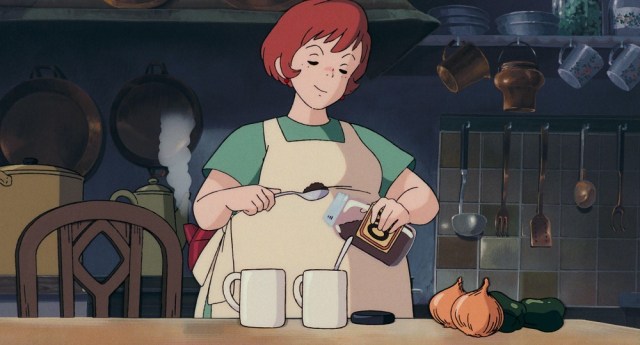
Recently, my wife and I went out to see the live-action Kiki’s Delivery Service. As we waited for the film to start, we swapped impressions of the 1989 anime version of the story, which like the live-action version is an adaptation of author Eiko Kadono’s 1985 children’s novel of the same name.
My wife mentioned that one of her favorite characters was Osono, the owner of the bakery where witch-in-training Kiki boards. Osono’s actually got quite a few fans, due to her tough yet kind personality and mature outlook on life.
How exactly Osono managed to acquire those admirable traits is the subject of a new serial by Kadono, a coming of age story focused on the baker who would eventually serve as Kiki’s mentor.
The first installment is already out, and can be read for free here on the webpage of Fukuinkan Shoten, the publisher for the six books in the Kiki’s Delivery Service series. The serial is officially titled Kiki’s Delivery Service Side Story: How Sono-chan Became Osono-san, and just as the name implies, it deals with how the young girl Sono grew up, in the process shedding the diminutive “-chan” suffix and replacing it with the more distinguished “-san,” along with adding an extra respectable “o” to the front of her name.
▼ Osono-san in the 1989 Ghibli Kiki’s Delivery Service
As the story opens, Sono-chan is just three years old, and living with her parents, who gave up their dreams of becoming actors in order to raise their child. In the course of the serial’s six chapters, readers will also learn more about how Sono-chan met and fell in love with her husband Fukuo, and the somewhat bumpy path along the way to when we see her carrying their first child in both Kiki’s films.
New chapters of How Sono-chan Became Ososno-san will be released on the 5th and 20th of each month from now through May. They’re free to read, and although there’s no English version available, none of the kanji characters are too difficult to handle as long as you’ve got a decent Japanese/English dictionary, making the mini-series ideal self-study material for language enthusiasts. And for students enrolled in a Japanese class, we can’t think of a better way to talk your teacher into a little extra credit than by whipping up translations of a few of its passages.
Related: How Sono-chan Became Osono-san
Source: IT Media
Top image: How Sono-chan Became Osono-san
Insert images: Studio Ghibli


 Live-action Kiki’s Delivery Service film’s new images feature Tonbo, Osono
Live-action Kiki’s Delivery Service film’s new images feature Tonbo, Osono Live-action Kiki’s Delivery Service film’s 2nd trailer previews Jiji
Live-action Kiki’s Delivery Service film’s 2nd trailer previews Jiji Tokyo Prince Hotel delivers a hint of magic with Kiki’s Delivery Service suite and bakery
Tokyo Prince Hotel delivers a hint of magic with Kiki’s Delivery Service suite and bakery Studio Ghibli releases new batch of Line app anime stamps, this time for Kiki’s Delivery Service!
Studio Ghibli releases new batch of Line app anime stamps, this time for Kiki’s Delivery Service! Anime fans pick which Ghibli heroine they’d like to have as a girlfriend
Anime fans pick which Ghibli heroine they’d like to have as a girlfriend McDonald’s new Happy Meals offer up cute and practical Sanrio lifestyle goods
McDonald’s new Happy Meals offer up cute and practical Sanrio lifestyle goods All-you-can-drink Starbucks and amazing views part of Tokyo’s new 170 meter-high sky lounge
All-you-can-drink Starbucks and amazing views part of Tokyo’s new 170 meter-high sky lounge Studio Ghibli releases new action figures featuring Nausicaä of the Valley of the Wind characters
Studio Ghibli releases new action figures featuring Nausicaä of the Valley of the Wind characters Super Nintendo World expansion gets delayed for several months at Universal Studios Japan
Super Nintendo World expansion gets delayed for several months at Universal Studios Japan Studio Ghibli glasses cases let anime characters keep an eye on your spectacles
Studio Ghibli glasses cases let anime characters keep an eye on your spectacles Hamster abandoned at Tokyo ramen restaurant gets new home
Hamster abandoned at Tokyo ramen restaurant gets new home Ghibli Park Catbus picks up passengers for first time, with a very special number plate 【Videos】
Ghibli Park Catbus picks up passengers for first time, with a very special number plate 【Videos】 Dogs now allowed on Catbus! Ghibli Park vehicles revise service animal policy
Dogs now allowed on Catbus! Ghibli Park vehicles revise service animal policy It’s naked time: An American’s first onsen experience 【Video】
It’s naked time: An American’s first onsen experience 【Video】 Father and son dissect a gachapon capsule toy machine to show us its magical insides【Video】
Father and son dissect a gachapon capsule toy machine to show us its magical insides【Video】 More foreign tourists than ever before in history visited Japan last month
More foreign tourists than ever before in history visited Japan last month Disney princesses get official manga makeovers for Manga Princess Cafe opening in Tokyo
Disney princesses get official manga makeovers for Manga Princess Cafe opening in Tokyo Starbucks reopens at Shibuya Scramble Crossing with new look and design concept
Starbucks reopens at Shibuya Scramble Crossing with new look and design concept Beautiful new Final Fantasy T-shirt collection on the way from Uniqlo【Photos】
Beautiful new Final Fantasy T-shirt collection on the way from Uniqlo【Photos】 Is the new Shinkansen Train Desk ticket worth it?
Is the new Shinkansen Train Desk ticket worth it? Foreign English teachers in Japan pick their favorite Japanese-language phrases【Survey】
Foreign English teachers in Japan pick their favorite Japanese-language phrases【Survey】 Beautiful Sailor Moon manhole cover coasters being given out for free by Tokyo tourist center
Beautiful Sailor Moon manhole cover coasters being given out for free by Tokyo tourist center Studio Ghibli releases Kiki’s Delivery Service chocolate cake pouches in Japan
Studio Ghibli releases Kiki’s Delivery Service chocolate cake pouches in Japan Japan’s bone-breaking and record-breaking roller coaster is permanently shutting down
Japan’s bone-breaking and record-breaking roller coaster is permanently shutting down New definition of “Japanese whiskey” goes into effect to prevent fakes from fooling overseas buyers
New definition of “Japanese whiskey” goes into effect to prevent fakes from fooling overseas buyers Our Japanese reporter visits Costco in the U.S., finds super American and very Japanese things
Our Japanese reporter visits Costco in the U.S., finds super American and very Japanese things Studio Ghibli unveils Mother’s Day gift set that captures the love in My Neighbour Totoro
Studio Ghibli unveils Mother’s Day gift set that captures the love in My Neighbour Totoro Domino’s Japan now sells…pizza ears?
Domino’s Japan now sells…pizza ears? New Japanese KitKat flavour stars Sanrio characters, including Hello Kitty
New Japanese KitKat flavour stars Sanrio characters, including Hello Kitty One of Tokyo’s most famous meeting-spot landmarks is closing for good
One of Tokyo’s most famous meeting-spot landmarks is closing for good Kyoto creates new for-tourist buses to address overtourism with higher prices, faster rides
Kyoto creates new for-tourist buses to address overtourism with higher prices, faster rides Sales of Japan’s most convenient train ticket/shopping payment cards suspended indefinitely
Sales of Japan’s most convenient train ticket/shopping payment cards suspended indefinitely Sold-out Studio Ghibli desktop humidifiers are back so Totoro can help you through the dry season
Sold-out Studio Ghibli desktop humidifiers are back so Totoro can help you through the dry season Japanese government to make first change to romanization spelling rules since the 1950s
Japanese government to make first change to romanization spelling rules since the 1950s Ghibli founders Toshio Suzuki and Hayao Miyazaki contribute to Japanese whisky Totoro label design
Ghibli founders Toshio Suzuki and Hayao Miyazaki contribute to Japanese whisky Totoro label design Doraemon found buried at sea as scene from 1993 anime becomes real life【Photos】
Doraemon found buried at sea as scene from 1993 anime becomes real life【Photos】 Tokyo’s most famous Starbucks is closed
Tokyo’s most famous Starbucks is closed One Piece characters’ nationalities revealed, but fans have mixed opinions
One Piece characters’ nationalities revealed, but fans have mixed opinions We asked a Uniqlo employee what four things we should buy and their suggestions didn’t disappoint
We asked a Uniqlo employee what four things we should buy and their suggestions didn’t disappoint Princesses, fruits, and blacksmiths: Study reveals the 30 most unusual family names in Japan
Princesses, fruits, and blacksmiths: Study reveals the 30 most unusual family names in Japan Studio Ghibli releases 250 more free-to-download/use images from five films, and Totoro is here!
Studio Ghibli releases 250 more free-to-download/use images from five films, and Totoro is here! Studio Ghibli’s truck from My Neighbour Totoro now available as die-cast Takara Tomy car
Studio Ghibli’s truck from My Neighbour Totoro now available as die-cast Takara Tomy car 10 best Studio Ghibli anime, as picked by Japanese fans– Different ages have different answers
10 best Studio Ghibli anime, as picked by Japanese fans– Different ages have different answers Add some Ghibli magic to the table with scene-stealing goods from Kiki’s Delivery Service
Add some Ghibli magic to the table with scene-stealing goods from Kiki’s Delivery Service Studio Ghibli diorama calendars will put a little whimsy on your desktop all year long【Photos】
Studio Ghibli diorama calendars will put a little whimsy on your desktop all year long【Photos】 Ghibli Park releases new info, preview images for Howl’s Moving Castle, Princess Mononoke areas
Ghibli Park releases new info, preview images for Howl’s Moving Castle, Princess Mononoke areas Studio Ghibli makes every day magical with new Spirited Away, Totoro and Kiki calendars
Studio Ghibli makes every day magical with new Spirited Away, Totoro and Kiki calendars Traveling with Totoro (and Kiki too)! Official Studio Ghibli suitcases go on sale
Traveling with Totoro (and Kiki too)! Official Studio Ghibli suitcases go on sale Animal Crossing fan recreating all of Ghibli’s Spirited Away in New Horizons, and it’s incredible
Animal Crossing fan recreating all of Ghibli’s Spirited Away in New Horizons, and it’s incredible New Studio Ghibli clocks let you keep an eye on the time with your favourite anime characters
New Studio Ghibli clocks let you keep an eye on the time with your favourite anime characters Toronto Film Festival to host North American premiere of Princess Kaguya, Ghibli documentary
Toronto Film Festival to host North American premiere of Princess Kaguya, Ghibli documentary Ghibli moss art discovered along mountain road in Japan
Ghibli moss art discovered along mountain road in Japan Artist carves cute Studio Ghibli characters into Oreo cookie filling 【Video】
Artist carves cute Studio Ghibli characters into Oreo cookie filling 【Video】 New Kiki’s Delivery Service and Howl’s Moving Castle products now available from Donguri Closet
New Kiki’s Delivery Service and Howl’s Moving Castle products now available from Donguri Closet British newspaper ranks the best Studio Ghibli films and reader passions flare
British newspaper ranks the best Studio Ghibli films and reader passions flare
Leave a Reply